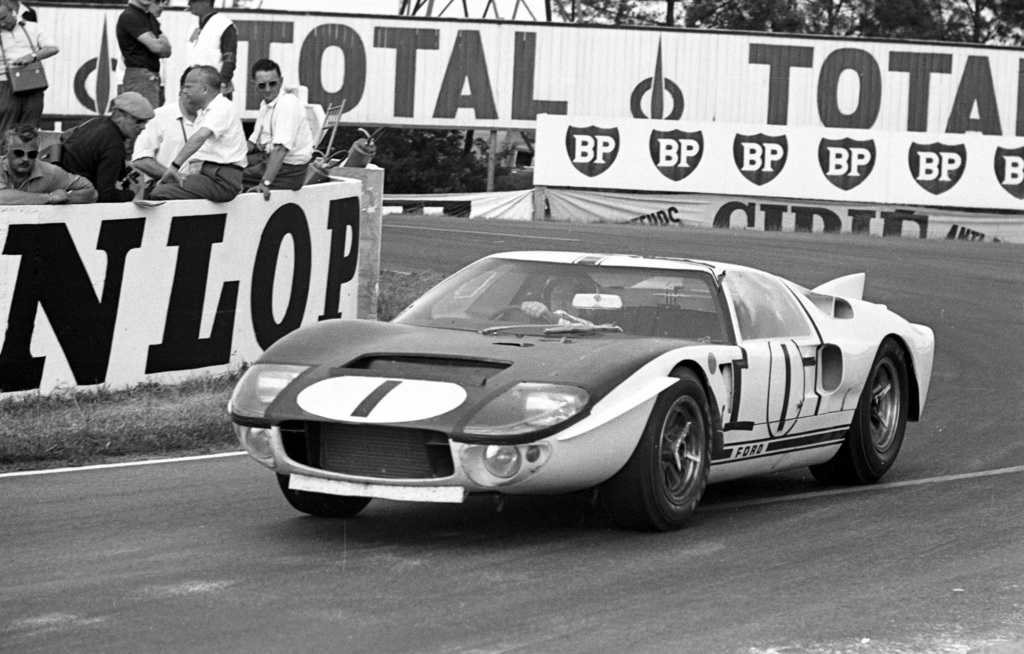| Racing with Shelby American | Ken Miles | |
| 1964 The Beginning Part 1 | MkII – 1966 the 427 Part 3 | |
| 1965 Shelby Takes Over Part 2 | 1967-68-69 Part 4 |
After a disastrous 1964 racing season, Ford turned the GT40 project over to Carroll Shelby and Shelby American. Ford’s team had proven the GT40’s could compete with the best of Europe but 10 DNFs out of 10 starts called for an experienced hand. The Shelby American team had been winning a lot of races with the Cobras. Even though the Cobras were Ford powered, they weren’t Fords. Cobras were a hybrid car at best. And Lee Ioccoca at Ford Motor Company wanted Ford to have racing victories. Ford asked Shelby to pull the factory support of the Cobras and race the GT40’s instead. Carroll Shelby had no trouble understanding the request and closed down the official Cobra racing efforts, devoting all Shelby American’s efforts to win with the GT40’s.
During the 1964 season, GT40’s couldn’t stay in the races. Engines would break. Transmissions burnt up. The first thing the Shelby team did was pull the exotic, troublesome engines and replaced them with the tried and true 380 HP 289 CID. The Shelby team also reconstructed the unreliable ZF 5 speed transaxle (21 changes in all).
The first thing Shelby did was make Carroll Smith Team Manager. He recruited Shelby American chief engineer Phil Remington and driver Ken Miles to help work the problems out of the cars. John Wyler continued at Ford Advanced Vehicles assembling the cars from sub-contracted parts.
The GT40’s couldn’t win as they were. The exotic Indy F.A.V. (Fairlane) 4.2 liter block had to go. It was replaced with the race proven 289. The dry oil sump system was replaced with a wet sump which also saved about 50 lbs. The Colotti transaxle had to be modified until new ZF transaxles arrived. It hadn’t lasted more than six hours in any one race. A Ford engineer fashioned a hardened ring and pinion gear to replace the unreliable stock ones. The poor aerodynamics were altered. The cooling system was enlarged. Oil and transmission cooling was improved. Much larger disc brakes went on the front. The cars were painted Shelby American colors – twin white stripes on a medium blue body.
The cars had to be race ready for Daytona in eight weeks. After the cars were cleaned up, given a paint job and the engines replaced, Ken Miles and Bob Bondurant test drove them at Riverside track. The cars had both understeer & oversteer. The narrow tires on the wire rims caused the car to slide around a lot. Ken Miles told Carroll Smith the GT40 handled so terribly he wouldn’t drive it again until problems were fixed. One of the most key changes was replacing the heavy wire wheels and narrow tires with Halibrand magnesium wheels with wide Goodyear tires. Not only did that switch save 30 lbs., the GT40’s handled remarkably better.
Development continued right up to the Daytona Continental 2,000 KM Race. The cars were continuously tested and changed. At Daytona, front and rear spoilers were added after it was discovered that they were unstable at high speed during banking. The GT40 driven by Ken Miles and Lloyd Ruby won the Daytona Continental race. Leo Beebe and Ray Geddes of Ford were there to witness it. In eight weeks, the Shelby team had converted a losing car to a winner and on their first time out. Sebring was next.
Shelby’s GT40‘s won the first two races in ’65. Monza, Targa and Nurburging weren’t as successful. But the 24 Hours of LeMans was the race targeted to win. Now Ford & Shelby had a secret weapon against Ferrari.
Shelby’s GT40 team won the first two races of the 1965 season at Daytona and Sebring. The next three races, Monza, Targa and Nurburging were disappointing at best. Bob Bondurant was driving a GT40 with John Whitmore at Targa. The race was only 10 laps long but each lap was 45 miles. They drove it to as high as third place prior to some mechanical problems and a crash. The car had a continuous oil leak during practice. They thought was it fixed. When Bondurant pitted, half of the oil was laying on the floor. During Whitmore’s turn at the steering wheel the left front wheel came off. A local Silician found the knockoff that secured the wheel planning to keep it as a souvenir. Whitmore talked him into giving it back and put the wheel on the GT40. Back in the pits, Bondurant took over. On the track, Bob hit some loose gravel, went off the road and hit one of the kilometer markers buried along the track. It smashed the front of the car, put the car up on two wheels almost flipping the car over. It landed on all four wheels. Bondurant got out the car and started walking back to Cerda. Along the way he came across a bar in a hotel and that’s where Carroll Smith later found him.
But while the GT40’s were being prepped, Ferrari and the competition were also gearing up for the upcoming confrontation. More horsepower was needed for the GT40 so Shelby’s team modified a Mk I to accommodate the 7 liter 427 CID. The small block would power the GT40’s to 200 MPH. But the 500 HP 427 topped 210 mph the first time out with Ken Miles at the wheel. Called Mk IIs, the big block GT40’s were plagued with aerodynamics & high speed handling problems.
At LeMans in `65 the GT40’s ran off with the race only to succumb one at a time to problems with the new Kar Kraft 5 speed transaxles. The small block GT40’s had gearbox and cylinder head problems. All dropped out of the race. Ford once again pulled out of European racing for the rest of the `65 season.
